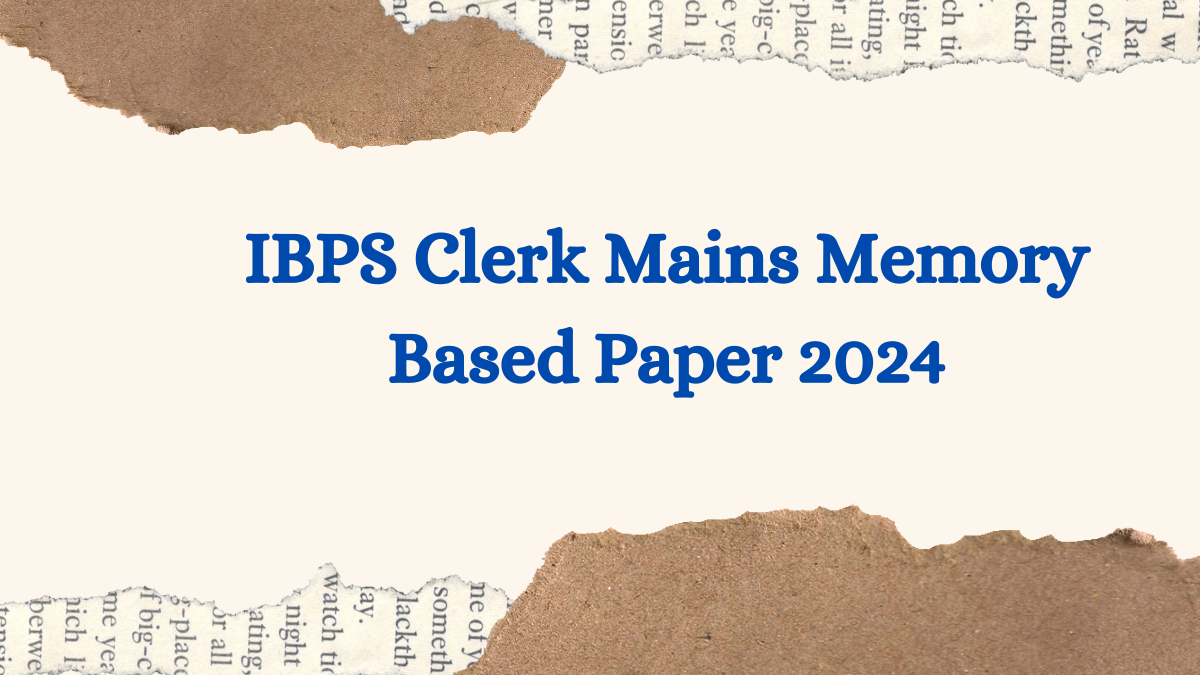The Institute of Banking Personnel Selection conducted the IBPS Clerk Mains Exam 2024 on 13 October 2024. Candidates who participated in the examination provided the most authentic and reliable IBPS Clerk Mains Exam Analysis 2024. Based on the students’ feedback and analysis of our team members we have provided the IBPS Clerk Mains Memory Based Paper 2024. The memory based paper will provide support to candidates in their preparation for future exams and provide an insight into the actual exam experience.
IBPS Clerk Mains Memory Based Paper 2024
IBPS Clerk Mains Memory Based Paper 2024 has been curated based on the questions asked in the exam, ensuring that candidates have access to the most relevant and accurate information. By working through this memory-based paper, candidates can evaluate the level of difficulty, familiarize themselves with the types of questions asked, and refine their strategies for upcoming attempts. With the IBPS Clerk Mains Memory Based Paper 2024, candidates can gain practical insights, fine-tune their preparation approach, and increase their chances of scoring well in future exam.
Till the attempt link of IBPS Clerk Mains Memory Based Paper 2024 gets activated or the PDF is provided, we have provided some of the practice questions based on the IBPS Clerk Mains Exam 2024.
Directions (1-5): Study the following information carefully and answer the given questions below:
There are eight employees A, B, C, D, E, F, G and H working in a company at different designations: CEO, Vice President (VP), Senior Manager (SM), Manager, Assistant Manager (AM), Junior Officer (JO), Clerk and Trainee. Each employee plays a different sport: Football, Cricket, Basketball, Hockey, Tennis, Badminton, Chess and Volleyball. The designations are ranked in order with CEO being the senior-most and Trainee being the junior-most. All the information is not necessarily in the same order.
The one who plays Badminton is designated just junior to D. A and G don’t play Tennis and Hockey. Three designations are between C and the one who plays Basketball. E is two designations junior to the person who plays basketball. C and E are not designated as the junior-most person and senior person. The number of persons senior to E is two less than the number of persons junior to the person who plays Badminton. More than four persons are designated between D and H who plays Cricket. As many persons senior to the person who plays Cricket as junior to the person who plays Hockey. B doesn’t play Badminton. The one who plays Chess is two persons senior than G. E and G don’t play Football. The person designated as Assistant Manager, F and B don’t play Chess.
Q1. Which among the following games B plays and how many persons are junior to B respectively?
(a) Seven, Hockey
(b) Five, Hockey
(c) Seven, Basketball
(d) Five, Basketball
(e) None of these
Q2. Which of the following pairs is correct?
(a) A – Senior Manager
(b) G – Clerk
(c) C – Clerk
(d) C – Junior Officer
(e) E – Manager
Q3. Which of the following statement is incorrect as per the given information?
(a) D is the designated as the CEO and plays Basketball
(b) F is designated junior to E.
(c) The person designated as Manager plays Chess.
(d) Four designations are there between F and G.
(e) All are incorrect
Q4. Which among the following is the designation of the person who plays Volleyball?
(a) Clerk
(b) Junior Officer
(c) Senior Manager
(d) Vice President
(e) Assistant Manager
Q5. How many designations are there between A and the one who plays Football?
(a) As many persons designated junior to the person who plays Tennis
(b) As many persons designated senior to the person who plays Hockey
(c) As many persons designated between F and C
(d) Four
(e) As many persons designated between E and H
Directions (6-8): Study the following information carefully and answer the given questions. In certain coding language, the directions are coded as per below conditions.
X@Y means – X is North of Y
X%Y means – X is South of Y
X#Y means – X is East of Y
X$Y means – X is West of Y
@ and $ means the distance between the two points is either 4m or 8m.
% and # means the distance between the two points is either 3m or 7m.
XY > WZ Means the distance between point X and point Y is greater than that of point W and point Z.
Example: A @ B and A $ B means A is north of B and A is west of B respectively and the distance between A and B is either 4m or 8m and so on.
Condition:
D#E, F%E, G@I, H#I, G$F, H@K, L#K, DE > KL, GI < GF, IH = KL
Q6. What is the direction of point E with respect to Point I?
(a) North-west
(b) South
(c) South-west
(d) North-east
(e) None of these
Q7. What is the shortest distance between Point I and Point K?
(a) 13m
(b) 8m
(c) 73m
(d) 113m
(e) Can’t be determined
Q8. How far (total distance) and in which direction is Point I with respect to Point F?
(a) 12m, North-east
(b) 10m, South-east
(c) 12m, South-west
(d) 8m, South
(e) None of these
Directions (9-10): In the questions below, a sentence is divided into several parts. Select the most appropriate sequence to rearrange the parts into a grammatically correct and contextually coherent sentence.
Q9. (A) of climate change and preserving
(B) is essential for mitigating the adverse effects
(C) and responsible resource management,
(D) including renewable energy usage, waste reduction,
(E) biodiversity for future generations
(F) adopting sustainable practices across industries,
(a) FDCBAE
(b) FDBCEA
(c) EBADAC
(d) EBACAD
(e) EBCFAD
Q10. (A) but also about fostering a culture of trust,
(B) encouraging open communication, and
(C) effective leadership within organizations is
(D) empowering team members to take
(E) ownership of their roles, ultimately driving collective success
(F) not only about making strategic decisions
(a) CDEBAF
(b) BDECFA
(c) CFABDE
(d) BDEAFC
(e) BCEDFA
Directions (11-12): In the following questions, a sentence is divided into several parts. One of the parts is grammatically correct, while the others contain errors. Identify the incorrect part(s) from the sentence. If all parts are correct, select “no error” as the answer.
Q11. To understand personal finance, (A)/ including budgeting and investing,/ empower individuals to make (B)/ informed decisions and (C) /achieve long-term financial security.(D)
(a) A
(b) A-B
(c) C-D
(d) D
(e) No error
Q12. Not only the team achieved (A)/ remarkable success in the project, / but never before they had encountered (B) / such challenges that tested their (C)/ skills and determination to this extent. (D)
(a) A-D
(b) A-B
(c) C-D
(d) D
(e) No error
Q13. Read the information and answer the given question.
John has consistently demonstrated a lack of punctuality, often arriving late to meetings and missing important deadlines, which has caused disruptions in the workflow of the team. Despite numerous reminders and opportunities to improve his time management skills, he continues to struggle with completing tasks on schedule, putting added pressure on his colleagues. Additionally, John has developed a reputation for being arrogant, dismissing constructive feedback from both peers and supervisors, and often undermining the efforts of others with an overconfident attitude. His reluctance to acknowledge these issues has created tension in the workplace, making it difficult for the team to collaborate effectively.
Based on the paragraph, what can be inferred about John’s work behavior?
(a) John frequently meets deadlines but struggles with maintaining a positive relationship with his team.
(b) John’s arrogance stems from the heavy workload he faces and the constant criticism he receives regarding his personal qualities.
(c) John acknowledges that he lacks necessary skills for the project and thus withdraws from it.
(d) John is not dependable for urgent projects due to his tardiness and arrogance.
(e) John is known for always providing constructive feedback to his peers.
Directions (14-18): Read the following pie chart and table carefully and answer the questions given below. The pie chart show the percentage distribution of total number of unsold toys (metallic and plastic) by four (A, B, C and D) different companies. The table shows the difference between the metallic and plastic toys sold by these four companies.
Note: (i) Total toys (metallic and plastic) manufactured by A, B, C and D are 40, 33, 25, and 38 respectively.
(ii) Metallic sold are more than plastic toys sold by each company.
(iii) Total toys manufactured = Total toys (metallic and plastic) sold + total toys unsold (metallic and plastic)
| Companies | Difference between the metallic and plastic toys sold |
| A | 2 |
| B | 12 |
| C | 3 |
| D | 5 |
Q14. Find the difference between the total number of metallic toys sold by A and C together and the total number of unsold toys by B and D together.
(a) 11
(b) 14
(c) 12
(d) 15
(e) 18
Q15. The total number of toys manufactured by E is 40% more than that of C and the total toys sold by E is half of the total toys sold by C and D together. The total unsold toys by E is what percentage more or less than the total plastic toys sold by C?
(a) 5%
(b) 10%
(c) 1.5%
(d) 2.5%
(e) 0%
Q16. Total number of unsold metallic toys by D is 10% of the total number of metallic toys sold by same company. Find the difference between the total number of plastic toys (sold and unsold) manufactured by D and the total number of toys sold by A.
(a) 12
(b) 11
(c) 10
(d) 14
(e) 13
Q17. Find the ratio of the total number of plastic toys sold by A and D together to the total number of toys unsold C and B together.
(a) 29:12
(b) 28:15
(c) 27:11
(d) 23:19
(e) 21:17
Q18. The average of total toys sold by C and the plastic toys sold by A is what percentage of the total metallic toys sold by D?
(a) 50%
(b) 75%
(c) 80%
(d) 66.67%
(e) None of these
Directions (19-21): Find the pattern of the series and answer the question given below.
Series: X, 168, 172, 145, Y, Z
Q19. Find the 8th term of the series.
(a) 271
(b) -324
(c) -271
(d) 324
(e) -218
Q20. Which of the following statement/s is are correct.
(i) X is greater than Y
(ii) Z is square of even number
(iii) X is less than Z
(a) All (i), (ii) & (iii)
(b) Both (ii) & (iii)
(c) Both (i) & (iii)
(d) Both (i) & (ii)
(e) Noe of the above
Q21. Find the Sum of the Y and Z.
(a) 182
(b) 167
(c) 197
(d) 198
(e) 209
Q22. A man invested Rs 5000 in a scheme that offers simple interest at 12% p.a. for ‘t’ years. He also invested an amount which is equal to double the interest obtained from the first scheme at the rate of 15% p.a. for 5 years in another scheme. If the amount received from the second scheme is Rs 6300, then find ‘t’
(a) 6
(b) 1
(c) 2
(d) 4
(e) 3
Q23. 200-meter-long train A can cross a pole in 8 seconds, and train B can cross a 150-meter-long platform in 25 seconds. The difference between the lengths of trains A and B is 150 meters (length of train B > length of train A). Find the time taken by the train to cross each other while running in the in the opposite direction.
(a) 135/11 seconds
(b) 119/12 seconds
(c) 111/16 seconds
(d) 120/7 seconds
(e) 110/9 seconds





 GA Capsule for SBI Clerk Mains 2025, Dow...
GA Capsule for SBI Clerk Mains 2025, Dow...
 The Hindu Review October 2022: Download ...
The Hindu Review October 2022: Download ...
 Weekly One Liners 24th to 30th March, 20...
Weekly One Liners 24th to 30th March, 20...




